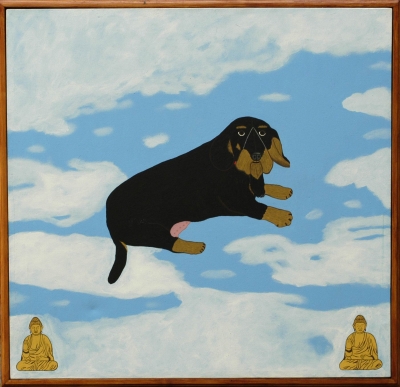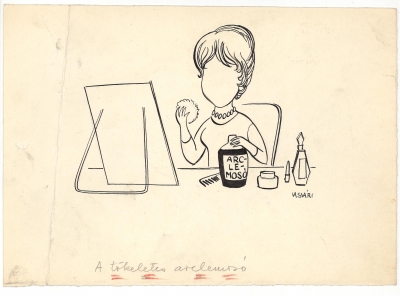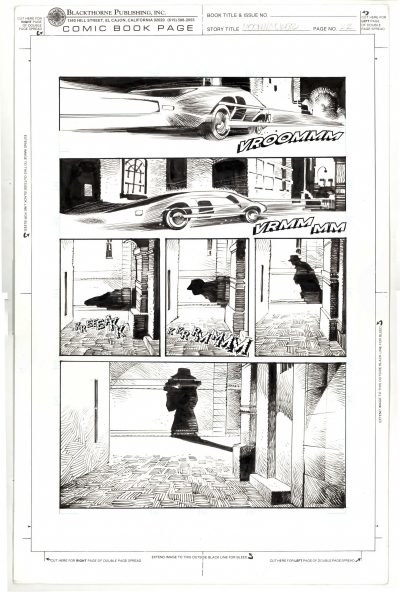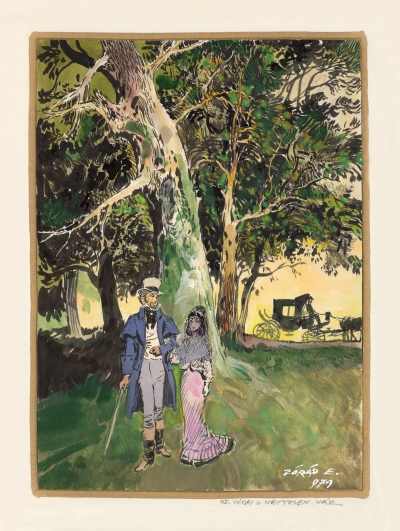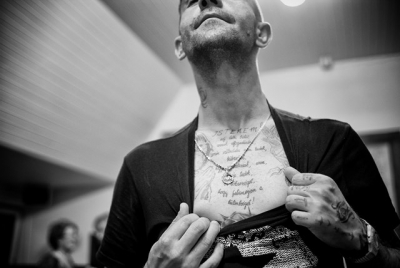art or business
Artwork of the week - Péter Hecker: Dodo
The vision of the dachshound, floating among the clouds, is not alien in the line of Péter Hecker’s paintings. Among the bright-coloured, cleared forms, every line and speckle carry some significance, and the abstract world on the paintings is familiar and strange at the same time. Besides the obvious humor and the creator’s playfulness, Hecker’s pictures also feature peculiar symbols, personal experience and self-reflection. kArton exhibited his paintings two times in 2001 and 2003.
Péter Hecker (1963, Budapest)
1990-96: Gesamthochschule, Kassel (viual communication, graphic design, photo, liberal arts courses)
1994-95: Hungarian University of Fine Arts, intermedia course, examural student
from 1996: member of Fiatal Képzőművészek Stúdiója and Magyar Alkotóművészek Országos Egyesülete
2000: Painting Prize of Magyar Aszfalt (2nd prize)
/Komornik Eszter/
Artwork of the week - Anna Vasvári: The perfect cleansing
Though usually we know Anna Vasvári because of her caricatures, after graduating from the School of Applied Arts (Iparrajziskola), she was working as a fashion designer for several years - it certainly had a great impact on her later work. From her work called Feminine Things, first a two-volume bookseries, then a movie was made and it won an award in the Viennese Filmweek in 1964.
From 1945, she was a permanent caricaturist in Ludas Matyi, but she also drew pictures for Magyar Konyha, Hahota, Béke és Szabadság or Magyar Ifjúság. Vasvári’s cheeky drawings are not only self-reflexive and ironic, but they also have clear and elegant lines and the message behind the content is always exceedingly strict.
As a matter of fact, her figures are as sassy and comical, as they are sincere and gentle.
In 2008, under the name of ‘Fashion and seduxen’, an exhibition was made in kArton Gallery from the works of the Munkácsy-award winner caricaturist.
/Komornik Eszter/
Artwork of the week - David B. Russel: Michael Jackson Moonwalker storyboard
Michael Jackson's trademark, the moonwalking inspired many people: in 1988 a film was made, and soon it was adapted into video game and comic book as well. For the comics, an enormous licensing fee was paid by Blackthorne Publishing, - which was the fifth largest U.S. comics publisher house that time, - thinking it would be an automatic hit. Sadly, they thought wrong, and the comics flopped — a significant financial hit that helped sink Blackthorne, only five years after its launching.
The Moonwalker comic book was released in the 3D line: Anaglyph 3D allows to see flat images in three dimension - thanks to the special technique and the 3D glasses -, intesifying the reader's experience.
This page is in an earlier stage in the method: they are not differentiated by color (commonly red and green), but the captions are already inlayed.
/Eszter Komornik/
Artwork of the week - Ernő Zórád: Nameless Castle
Novel-based comics own a very particular place in the medium’s history: even its name ('képregény' means 'graphic novel') comes from this tight literary bonding. Their structure was based on the American Classics Illustrated and the French Vaillant, and from the 1950-60s hundreds of comics appeared in various crossword and humor magazines. Hungarian comics researchers call this literature-supporting and distributing function the “socialist disguise” of the medium, and since they were always handled secondarily (due to their connection to the primary text), they never really had a chance to be judged on their own. Pál Korcsmáros, Attila Dargay, Attila Fazekas, Imre Sebők or Ernő Zórád - a few examples of the most famous comics artists.
Mór Jókai’s novel, the Nameless Castle was adapted by Zórád in 1979, and it was published in 18 parts on one spread in the Füles magazine. Five years later a publishing house called Táltos Kiadásszervezési GM released the comics in a separate, paperback booklet, and it was not just longer and bigger, but colored too. Its special feature was that Zórád made both the script and the graphic work, altough it was (and still is) a common practice, that the various work processes (writing, drawing, colouring, etc.) are often done by different people.
On this picture, you can see a panel from the Nameless Castle, without speech balloons and captions.
/Eszter Komornik/
Artwork of the week - Ferenc Simicz: Serenity Prayer, 2014
Serenity Prayer is the prayer of Alcoholics Anonymous and other twelve-step programs. The original, longer prayer was written by Reinhold Niebuhr, American theologian in 1926, and exists in many versions. The best-known short form is:
God, grant me the serenity to accept the things I cannot change,
The courage to change the things I can,
And the wisdom to know the difference.
The photo was taken by Ferenc Simicz, leader of the Drug Rehabilitation Centre in Komló.
With the picture he won first prize on 'Szerencsefüggőség' photo competition: https://www.facebook.com/szerencsefuggoseg

